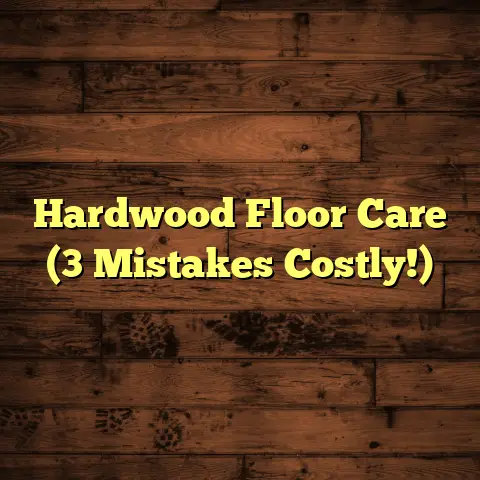Best Time To Lay Vinyl Flooring? (Now?)
Is Now the Right Moment?
Ever get that itch to renovate? I know I do! Let me tell you about Sarah. She finally decided to give her kitchen a long-overdue makeover. New cabinets, fresh paint, and the star of the show: vinyl flooring.She was so excited, envisioning her dream kitchen. But then came the big question: when to actually start the project? Should she jump in headfirst, or wait for the “perfect” time? That’s what we’re diving into today. Figuring out the best time to lay vinyl flooring. Is it now? Let’s find out!
Section 1: Understanding Vinyl Flooring
So, what exactly is vinyl flooring? It’s a synthetic flooring made from PVC (polyvinyl chloride) and other compounds. Think of it as the chameleon of the flooring world – it can mimic the look of wood, stone, tile, you name it!
There are a few main types you’ll run into:
-
Luxury Vinyl Tiles (LVT): These are individual tiles that offer realistic textures and patterns. They’re super durable and great for high-traffic areas.
-
Sheet Vinyl: This comes in large rolls and provides a seamless, water-resistant surface. It’s a budget-friendly option, perfect for bathrooms and kitchens.
-
Vinyl Planks: These look like hardwood planks, offering a realistic wood appearance with the added benefits of vinyl.
What makes vinyl so popular? Well, it’s a tough cookie. It can handle scratches, spills, and heavy foot traffic. Plus, it’s a breeze to clean – just a quick mop and you’re good to go.
And let’s not forget the looks! You can find vinyl flooring in just about any style imaginable. Want the look of rustic hardwood? No problem. Dreaming of sleek, modern tile? Vinyl’s got you covered.
Section 2: Factors Influencing the
Timing of Installation
Okay, so you’re sold on vinyl. Now, when should you actually install it? There are a few key things to consider.
Seasonal Considerations
Seasons play a HUGE role. Temperature and humidity can seriously impact the installation process.
-
Summer: Hot temperatures can make the adhesive dry too quickly, leading to bubbles or uneven surfaces. High humidity can also affect the adhesive’s bond.
-
Winter: Cold temperatures can make vinyl brittle and harder to work with. Plus, the adhesive might not bond properly if it’s too cold.
-
Spring & Fall: These are often the sweet spots. Moderate temperatures and humidity levels create ideal conditions for installation.
I’ve seen firsthand how temperature can mess things up. One summer, I was installing vinyl plank flooring in a sunroom. The adhesive was drying so fast, I barely had time to position the planks! It was a real headache.
Home Renovation Cycles
Think about it. When do most people decide to renovate? Often, it’s in the spring or fall. The weather’s nice, and people are getting ready for summer gatherings or holiday guests.
This means contractors can get booked up quickly during these peak seasons. And material prices might even go up due to increased demand. So, if you’re planning a spring renovation, book your contractor well in advance!
Personal Schedules
This is a big one! Make sure the installation aligns with your personal schedule. Do you have any big events coming up? Vacations planned? The last thing you want is to be living in a construction zone during your family reunion.
I always tell my clients to factor in extra time for unexpected delays. Things happen! Maybe the subfloor needs more work than anticipated, or a shipment of flooring gets delayed. It’s always better to be safe than sorry.
Section 3: The Installation Process
Alright, let’s talk about what actually goes into laying vinyl flooring.
Preparation is Key
First, you need to prep the subfloor. This means making sure it’s clean, level, and dry. Any imperfections in the subfloor will show through the vinyl, so it’s worth taking the time to do it right.
Next, you’ll need to gather your tools. A utility knife, measuring tape, straight edge, and adhesive (if you’re using glue-down vinyl) are essential.
Installation Methods
There are a few different ways to install vinyl flooring:
-
Glue-Down: This involves applying adhesive to the subfloor and then pressing the vinyl into place. It’s a more permanent option, ideal for high-traffic areas.
-
Click-Lock: This is a floating floor system where the planks or tiles click together. It’s a faster and easier installation method, perfect for DIYers.
-
Loose-Lay: This type of vinyl doesn’t require adhesive. It relies on its weight and friction to stay in place. It’s a great option for temporary installations or rentals.
Pro vs. DIY
Should you hire a professional, or tackle the installation yourself? There are pros and cons to both.
Professional Installers:
- Pros: Experience, expertise, warranty on labor, faster completion.
- Cons: Higher cost.
DIY:
- Pros: Lower cost, sense of accomplishment.
- Cons: Time-consuming, potential for mistakes, no warranty on labor.
I’ve seen some amazing DIY vinyl flooring installations. But I’ve also seen some real disasters! If you’re not confident in your skills, it’s always best to hire a pro.
Installation Time
The time it takes to install vinyl flooring depends on a few factors: the size of the room, the installation method, and your skill level.
Generally, a professional installer can complete a 200-square-foot room in a day or two. A DIYer might take a bit longer, especially if it’s their first time.
Section 4: Current Market Trends
What’s hot in the world of vinyl flooring right now? Let’s take a look.
Popular Styles
-
Wood-Look Vinyl: This is still hugely popular. Homeowners love the warmth and beauty of wood without the maintenance.
-
Waterproof Vinyl: With enhanced waterproof technology, this is a game changer for kitchens, bathrooms, and mudrooms.
-
Wide Plank Vinyl: Wide planks create a more spacious and modern look.
Colors and Patterns
Gray tones are still trending, but we’re also seeing a rise in warmer, more natural colors. Geometric patterns are also making a comeback, adding a touch of personality to any space.
Supply Chain Issues
Like many industries, the flooring industry has been affected by supply chain issues in recent years. This can lead to longer lead times and higher prices. So, it’s important to factor this into your timing.
I’ve had clients who had to wait weeks, even months, for their desired vinyl flooring to become available. It’s frustrating, but it’s the reality of the current market.
Section 5: Environmental Considerations
More and more homeowners are concerned about the environmental impact of their flooring choices. So, what about vinyl?
Sustainability Practices
Some manufacturers are now using recycled materials in their vinyl flooring. They’re also implementing more sustainable manufacturing processes.
Recycling Options
While vinyl flooring isn’t always easy to recycle, some programs are emerging to collect and recycle it. Check with your local waste management facility to see if they offer any options.
Eco-Friendly Vinyl
Look for vinyl flooring that is FloorScore® certified. This means it has been tested and meets strict indoor air quality standards.
Section 6: Homeowner Experiences
Let’s hear from some real homeowners who have recently installed vinyl flooring.
Testimonial 1: Maria
“I installed vinyl plank flooring in my basement last fall. I waited until the weather cooled down to avoid any issues with the adhesive. The installation went smoothly, and I’m so happy with the result!”
Testimonial 2: John
“I tried to install vinyl sheet flooring in my bathroom during the summer. The adhesive dried way too fast, and I ended up with bubbles and wrinkles. I had to rip it up and hire a professional. Lesson learned!”
Testimonial 3: Susan
“I chose eco-friendly vinyl flooring for my kitchen. It was important to me to make a sustainable choice. The installation was a bit more expensive, but I feel good about my decision.”
These stories highlight the importance of timing and preparation. They also show that choosing eco-friendly options is becoming a priority for many homeowners.
Section 7: Conclusion
So, what happened with Sarah and her kitchen renovation? Well, she ended up waiting until the fall to install her vinyl flooring. The weather was perfect, and she had plenty of time to prepare the subfloor. The installation went off without a hitch, and she’s now enjoying her beautiful new kitchen.
The truth is, there’s no one-size-fits-all answer to the best time to lay vinyl flooring. It depends on a variety of factors, including the season, your personal schedule, and the current market conditions.
But by understanding these factors, you can make an informed decision that sets you up for success. And who knows, maybe your vinyl flooring project will be as smooth and satisfying as Sarah’s!





